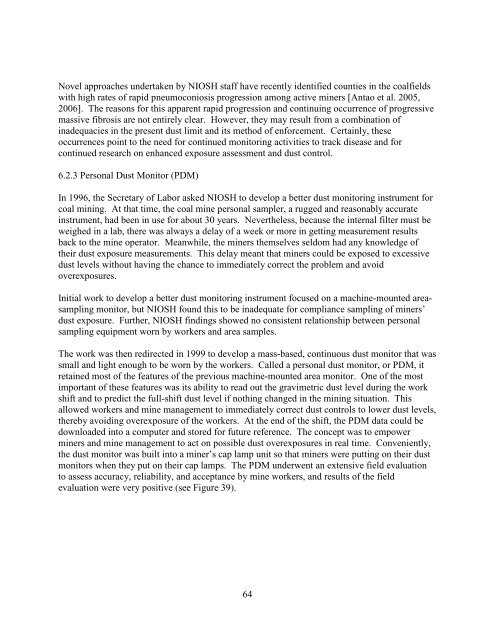One Hundred Years of Federal Mining Safety and Health Research
One Hundred Years of Federal Mining Safety and Health Research
One Hundred Years of Federal Mining Safety and Health Research
- No tags were found...
Create successful ePaper yourself
Turn your PDF publications into a flip-book with our unique Google optimized e-Paper software.
Novel approaches undertaken by NIOSH staff have recently identified counties in the coalfields<br />
with high rates <strong>of</strong> rapid pneumoconiosis progression among active miners [Antao et al. 2005,<br />
2006]. The reasons for this apparent rapid progression <strong>and</strong> continuing occurrence <strong>of</strong> progressive<br />
massive fibrosis are not entirely clear. However, they may result from a combination <strong>of</strong><br />
inadequacies in the present dust limit <strong>and</strong> its method <strong>of</strong> enforcement. Certainly, these<br />
occurrences point to the need for continued monitoring activities to track disease <strong>and</strong> for<br />
continued research on enhanced exposure assessment <strong>and</strong> dust control.<br />
6.2.3 Personal Dust Monitor (PDM)<br />
In 1996, the Secretary <strong>of</strong> Labor asked NIOSH to develop a better dust monitoring instrument for<br />
coal mining. At that time, the coal mine personal sampler, a rugged <strong>and</strong> reasonably accurate<br />
instrument, had been in use for about 30 years. Nevertheless, because the internal filter must be<br />
weighed in a lab, there was always a delay <strong>of</strong> a week or more in getting measurement results<br />
back to the mine operator. Meanwhile, the miners themselves seldom had any knowledge <strong>of</strong><br />
their dust exposure measurements. This delay meant that miners could be exposed to excessive<br />
dust levels without having the chance to immediately correct the problem <strong>and</strong> avoid<br />
overexposures.<br />
Initial work to develop a better dust monitoring instrument focused on a machine-mounted areasampling<br />
monitor, but NIOSH found this to be inadequate for compliance sampling <strong>of</strong> miners’<br />
dust exposure. Further, NIOSH findings showed no consistent relationship between personal<br />
sampling equipment worn by workers <strong>and</strong> area samples.<br />
The work was then redirected in 1999 to develop a mass-based, continuous dust monitor that was<br />
small <strong>and</strong> light enough to be worn by the workers. Called a personal dust monitor, or PDM, it<br />
retained most <strong>of</strong> the features <strong>of</strong> the previous machine-mounted area monitor. <strong>One</strong> <strong>of</strong> the most<br />
important <strong>of</strong> these features was its ability to read out the gravimetric dust level during the work<br />
shift <strong>and</strong> to predict the full-shift dust level if nothing changed in the mining situation. This<br />
allowed workers <strong>and</strong> mine management to immediately correct dust controls to lower dust levels,<br />
thereby avoiding overexposure <strong>of</strong> the workers. At the end <strong>of</strong> the shift, the PDM data could be<br />
downloaded into a computer <strong>and</strong> stored for future reference. The concept was to empower<br />
miners <strong>and</strong> mine management to act on possible dust overexposures in real time. Conveniently,<br />
the dust monitor was built into a miner’s cap lamp unit so that miners were putting on their dust<br />
monitors when they put on their cap lamps. The PDM underwent an extensive field evaluation<br />
to assess accuracy, reliability, <strong>and</strong> acceptance by mine workers, <strong>and</strong> results <strong>of</strong> the field<br />
evaluation were very positive (see Figure 39).<br />
64
















